Fix Bat Drag Hitting Drills: 3 Tips To Avoid For Baseball & Softball Beginners
Discover how to fix bat drag with these hitting drills. Learn 3 tips to avoiding bat drag for baseball and softball beginners.
Never Suffer From Bat Drag Again
Here are the TOP-3 blog posts in 2014 on fixing bat drag, based on my Google Analytic Metrics, that are still relevant today! The top-3 were:
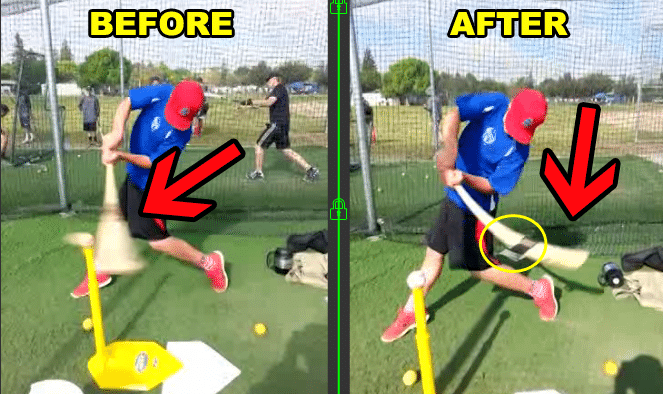
One of my High School hitters Keenan, using the Swing Blaster to ADD more barrel on the plane of the pitch (swings are synced).
- Baseball Training Aids: Long Slow Swing Fix?,
- Josh Donaldson: Stay CLOSED & Add Ball Exit Speed, and
- Youth Baseball Online ALERT: Hitting Fix For Bat Drag…
PLEASE NOTE that along long the bat drag lines, I recently tapped into my readers’ knowledge-base with this article titled, Hitting Tips To Boost Barrel Time On Pitch-Plane, that offered up some handy gold nuggets for correcting bat drag. There almost 30 comments! So go check it out and get involved in the discussion.
To refresh your BEST-of 2014, let’s recap by hitching a ride in my time baseball and softball hitting machine…
SCIENCE-BASED TRAINING:
Improve your hitting strategy dramatically by applying human movement principles.
Learn not only how and what to train but also the science behind the methods.
Baseball Training Aids: Long Slow Swing Fix?
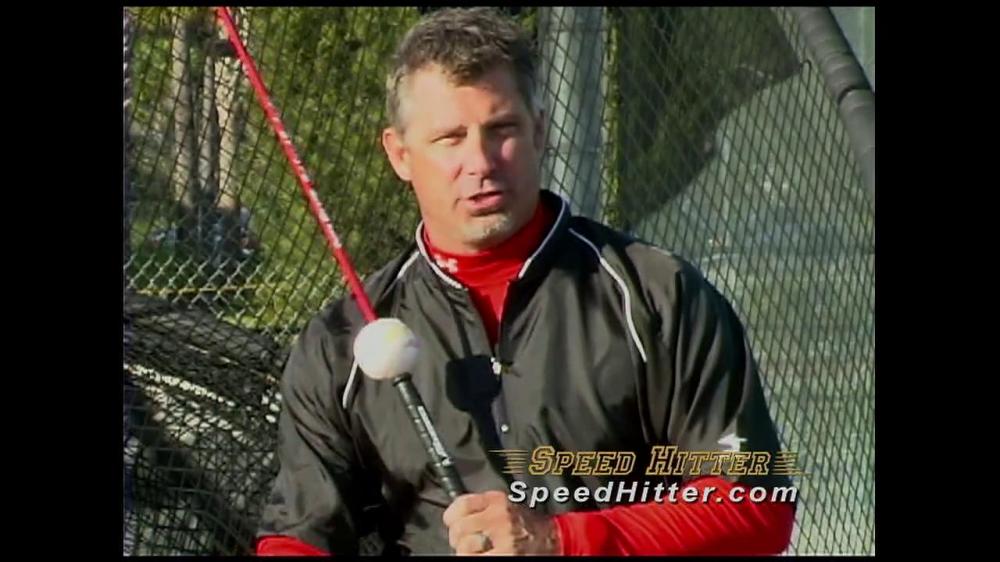
SpeedHitter promo featuring Tampa Bay Rays hitting coach Derek Shelton. Photo courtesy: Momentus Sports YouTube video
In this baseball online post, we talked about:
- Speed Hitter baseball training aid review,
- Barrel path science, and
- A better alternative…
CLICK HERE for a 2-minute Swing Hitter demo video. Momentus Sports promises the Speed Hitter will help a hitter achieve four ingredients all great hitters do (watch the video to see what they are). When proven human movement science is applied to the Speed Hitter, it doesn’t deliver on any of the promises.
Unbeknownst to Momentus Sports, the question the Speed Hitter attempts to answer is, “When is the barrel suppose to accelerate?” Is it at impact or before impact? The answer is the latter, but the Speed Hitter’s focus is the former. So, what better alternative is there? The Swing Blaster. Focus should be on hearing a clear audible “click” before impact, NOT at contact.
Post UPDATE: Click Here for an article on how barrel path changes based on pitch dept (e.g. middle-in versus middle-away pitch).
Josh Donaldson: Stay CLOSED & Add Ball Exit Speed
In this baseball online video, we analyzed:
- Josh Donaldson v. Jose Bautista metrics,
- What “staying closed” means to spine engine mechanics, and
- Where Josh Donaldson might be leaking force at impact.
How eerily similar Jose Bautista and Josh Donaldson’s body types AND swings are. CLICK HERE to listen (start at the 1 min, 10 sec mark) to Josh Donaldson discuss how he modeled his swing after Jose Bautista. This was an interview after being traded from Oakland to Toronto. By the way, this post got some air time on Canada’s National Post!
In the above post, “staying closed” DOES NOT mean an inward turn of the hips – towards the catcher – to “load”. It also has ZERO to do with striding with a closed front foot. But what this baseball online BEST-of post does do, is go into the counter-rotation of the shoulders – versus the pelvis – during the fall. Or what my hitters will tell you, “showing the pitcher their numbers.”
Upon analysis, it was interesting to note that Josh Donaldson didn’t commit his weight to his front side like Jose Bautista did. And this led to inferior ball exit speeds and a lower average home-run distance because of an inefficiency to use Gravitational Forces.
Youth Baseball Online ALERT: Hitting Fix For Bat Drag
In this baseball online post, we went over:
- What is Bat Drag?
- The science of Bat Drag (to hitting an unknown moving pitch), and
- How-to fix Bat Drag.
Youth bat drag is causes mostly by over rotation of the upper and/or lower half. It is NOT like what some coaches say, being caused by a dominant top hand or back arm, quite the opposite actually. Bat drag can be caused by a weak and disconnected top hand and back arm.
This article I originally posted back in 2015, and blamed bat drag on a barred out-front arm. I’ve since revised my position on this thanks to Perry Husband. A barred out-front arm DOES NOT result in a long slow swing, an early barrel in the hitting zone does. Specifically on pitches that are middle in. For a refresher on how barrel path changes based on pitch depth, then click this post.
- Fix Late Swings Fast: 2025 Pitch Recognition & See-Decide-Swing Training for Youth Baseball Power Hitters - October 6, 2025
- Safe Youth Weighted Bat Training: Proven Overload/Underload Drills to Increase Exit Velocity in Games Starting Tonight - September 29, 2025
- AI Coaching Course 2025: Youth Baseball & Softball Practice Plan + Off-Season & In-Season Workout Builder Fast - September 23, 2025

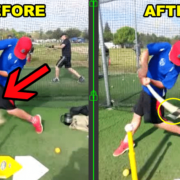

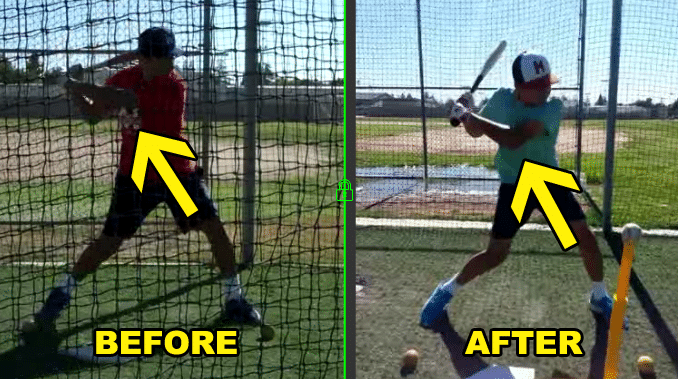






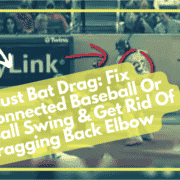




Joey… Regarding bat drag, here is what I believe:
1. Bat drag can’t be fixed with physical or positional changes. These positional changes may delay the the rotation of the shoulders, but do not change the overall wrong understanding of a swing. Bat drag is fixed when the swing sequences different.
2. The opposite of bat drag is casting the barrel away from the body BEFORE the shoulders rotate AT ALL.. You can’t have bat drag if the “V” (right forearm to upper arm angle) opens up before the shoulders rotate. A bat dragger thinks he can open the shoulders as fast as this “V” …. which is impossible for them.
3. Hitting pitching with bat drag can make fixing bat drag take a lot longer. The harder the pitching, the more the hitter with bat drag will spin the shoulders open and almost always their head never stops moving forward at foot plant…. leaving the bat barrel even further behind.
4. The mechanic that the hitter needs to to get the feel of a proper swing is to go to the golf range and hit hooks. It is very difficult to hook a golf ball without whipping the barrel out in front of your belly with your chest facing the ball. It’s a sequencing issue.
5. To test if you are eliminating your bat drag, a righty should be able to hook a low and inside ball (on a batting tee) foul down the third base line. The ball should curve right to left more than a few feet. The mechanic that can do this will not exhibit bat drag. Balls hit a shortstop should also have a hook but slighter.
6. After the arm to torso sequencing issue is fixed, the next issue is to learn how to develop whole body methods of using the legs and core to jump start the swing. Also, the head can’t move forward once the front foot lands and loads up.
Ah Kyle, I love how you’re using golf sequencing to address bat drag. Golfers have the same issue here right? So back arm action has to open first, before the shoulders? I was thinking about this today about getting the correct lag movement down, and would swinging a 5-foot garden utility stick or even a “mascot flag” help with feeling lag? I like the “hook” idea. Awesome stuff Kyle, thanks for sharing 🙂
Golfers don’t suffer from bat drag type swings because the ball is in the middle of the stance basically (except for longer clubs). A bat drag swing can’t even hit a golf ball because the club would never get down to ball level. Basically, bat dragers never open the V up till way too late. Plus, the golf ball gives feedback. It tells the golfer everything about his swing. If the ball starts left the path is out to in. Ball starts right, in to out. Ball starts left then curves right, open face and out to in. Ball starts right and hooks left, club closed coming from the inside.
The finer points in hitting are never looked at because hitters don’t look at the curve of the ball for feedback. In golf the plane of the swing and contact is scrutinized by the golfer each swing. In baseball, it is rarely if ever examined. All it takes is a look at the home runs hit in the Little League World Series. I would guess that 90% of the home runs were glancing blows. The composite bat covers a multitude of swing inefficiencies. The swings you see there do not translate at higher levels where swing plane has to be much better matching the plane of the pitch.
I totally agree. Where people get this wrong is they swear off analyzing golf swings because “baseball is different”. Wait a minute here…slightly, but human movement laws are human movement laws. It doesn’t matter what skill you’re doing, the laws are there 100% of the time. I love your outlook on this. I directed another reader (Mike) to your comments because his son is suffering from racing back elbow.